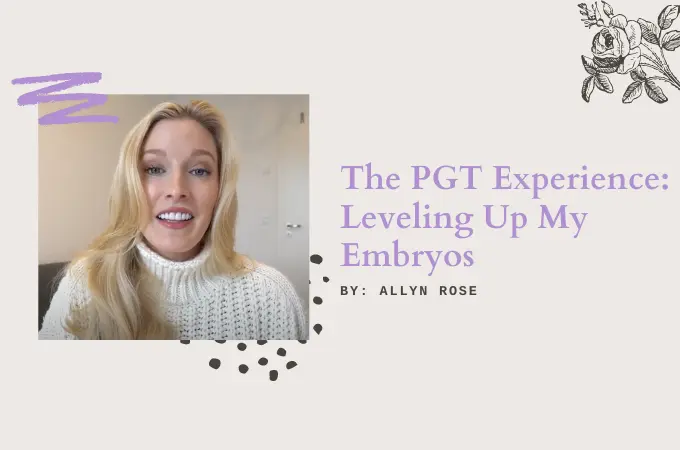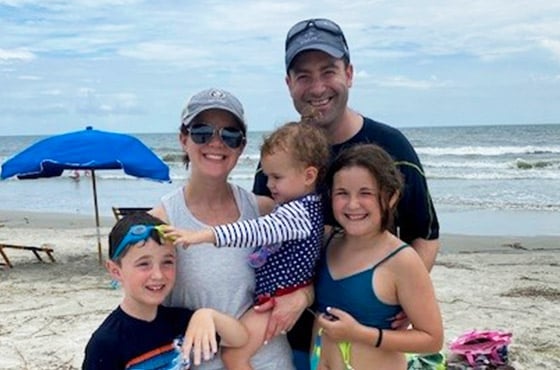Last fall, we introduced our community to Allyn Rose, a breast cancer previvor, well known women’s health advocate, former Miss USA and Miss America contestant, and full-time model.
Under the care of Dr. Kate Devine, Allyn decided to go through IVF treatment and PGT-M to reduce the risk of having a child with an inherited condition.
Allyn is documenting her journey to motherhood via blogs and videos in hopes that it will lift the veil of the unknown associated with infertility treatment, and also serve as a reminder to women to be their own advocate. “I hope that it will ‘pay it forward’ to other women going through this and help them realize that they aren’t alone either.”
Catch up on Allyn’s journey:
Blog #1: Why I am Undergoing IVF Treatment
Blog #2: The IVF “Firsts” What to Expect
Blog #3: What It’s Like Giving Yourself IVF Injections
Blog #4: My Egg Retrieval Experience
READ ALLYN’S FIFTH BLOG ABOUT HER EGG RETRIEVAL EXPERIENCE:
When I say that Christopher and I are undergoing IVF, most people generally understand what that means: your ovaries are stimulated to produce eggs, a doctor retrieves those eggs and fertilizes them outside of your body, then they are transferred to your uterus to hopefully become a successful pregnancy! But the second you add “with PGT” after IVF, you start to see furrowed brows as they wrack their brains trying to figure out what the heck PGT stands for…
PGT (preimplantation genetic testing) is an IVF “add on” that is used to identify potential issues with embryos prior to implantation. This comes in two forms: PGT-M and PGT-A. PGT-M is used to help reduce the risk of having a child with a known inherited disorder (like BRCA 1/2 or cystic fibrosis) caused by mutations in a single gene (Monogenic). PGT-A screens embryos for sporadic chromosome abnormalities by counting the 46 chromosomes to look for extra or missing chromosomes (Aneuploidy). Still with me? Good!
Essentially, PGT is “leveling up” your chances of a pregnancy by ensuring that the embryo you transfer has the best chance for success. It’s also a huge relief for people like me who carry a single gene mutation because it means that you have the opportunity to eliminate a dangerous genetic disease from your family tree! After losing three of my uncles to my rare genetic disease, I knew that I wanted to do everything that I could to ensure that my children were gene and carrier free. That meant undergoing IVF with PGT. Even though it seemed a little intimidating to tack on an extra step in the IVF process (and to manage the TWO WEEK WAIT for the results), I knew that it was the right choice for me and my family. After consulting with my doctor, Dr. Devine, at Shady Grove Fertility, I felt even more confident that it was the right decision.
SGF recommended that we use the genetics lab Igenomix for our PGT testing. After seeing that they had over 15 years of experience and were an industry leader, I felt comfortable sending off my “embryo friends” for testing. Christopher and I opted for PGT-A as well as PGT-M. This meant that we were able to not only screen for the genetic disease that I carry, but also able to identify any chromosomal abnormalities in my embryos. That way I knew that I was “covering all my bases.”
Even thought PGT is probably the most elaborate and detailed part of the IVF process, it was a piece of cake for me! All I had to do was sit back and let the experts do the work! After my egg retrieval, the embryologist determined which of my eggs were mature enough to be fertilized. Those remaining mature eggs were fertilized, creating embryos. Those embryos grew undisturbed for 5 days. At Day 5, the embryologist “peeked” to see which of those embryos had made it to the blastocyst stage of cell division. Those lucky 9 embryos were then biopsied (a small piece of genetic material was removed from the outer shell) and sent off to Igenomix for PGT.
Sounds like a lot, right? Well, it is pretty complicated stuff, but I knew that I was in great hands and that the experts were doing their best to ensure that Christopher and I will have a healthy baby.
After the biopsied material was sent to Igenomix, we just had to get through the dreaded “Two Week Wait.” It takes, on average, two weeks to receive your PGT test results. That might not sound like a lot, but when you’re waiting to hear about the genetic health of your precious embryos, it can feel like a lifetime. My impatience escalated quickly…
To make matters worse, my two week wait turned into a THREE WEEK WAIT. Sometimes you just get unlucky and it takes a little longer than two weeks. Unfortunately that was me…
I finally got a call from Dr. Devine – the results were in! Out of our 9 embryos, 3 were PGT-A and PGT-M clear! Christopher and I were thrilled. This meant that coupled with our first round of IVF with PGT, we were able to bank 4 healthy embryos to start our family. Christopher and I want 2-3 children so 4 is a great number heading into our first transfer. This wasn’t an easy process, but knowing that we have done everything that we can to protect our future children from my genetic disease has given me an incredible peace of mind.
Next up is our transfer! Stay tuned for more!
Continue following Allyn’s IVF journey on Shady Grove Fertility’s Instagram, YouTube Channel and Enewsletter!






